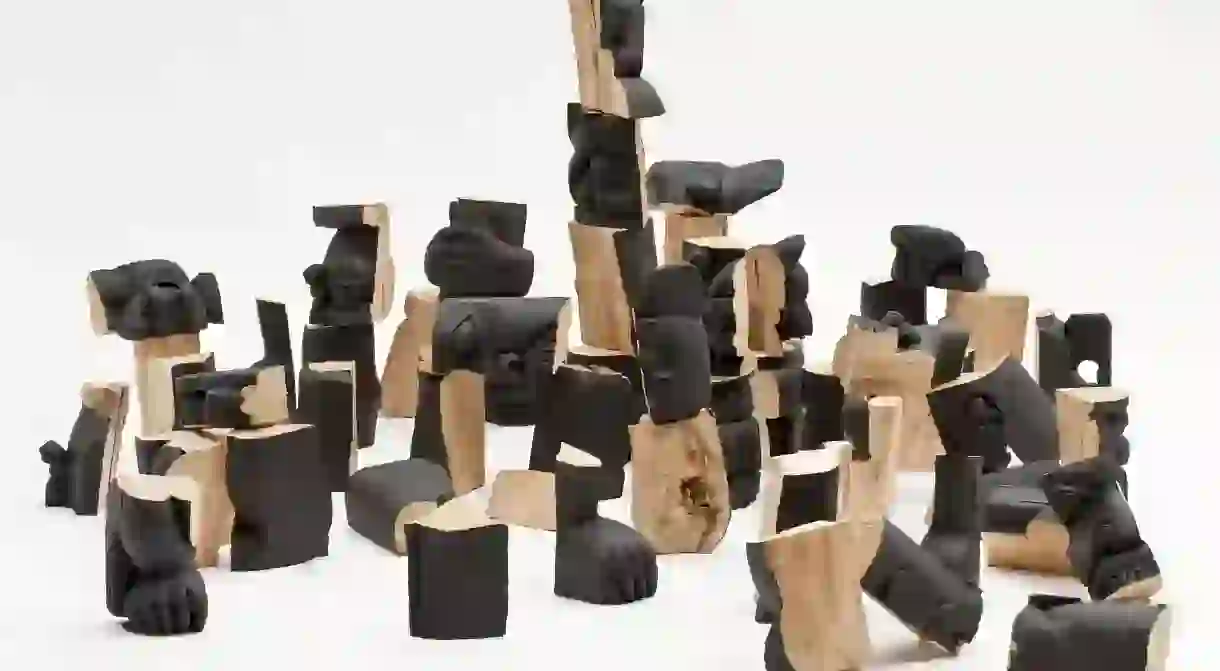Discover the Story Behind Native American Contemporary Art

Artist Holly Wilson is a different kind of storyteller. A multimedia artist dabbling in everything from dreamy encaustics to bronze works, the award-winning stories she tells are showcased in art galleries across the world. And as a member of the Delaware Nation/Cherokee tribes, her talents give life to tales seeped in distinct oral storytelling tradition.
“As I’m building the work, I’m building the story,” Wilson says. “And that, to me is my direct link to my history. My culture. So everything I have has a reason or a story behind it. And there was always this idea where everyone would tell the stories of their tribe. You would get an influx of a bunch of people, from a bunch of different tribes.”
Across the United States, contemporary native artists like Wilson are finally having their moment. While previously – and erroneously – relegated to anthropologic sections of art galleries, a handful of institutions are starting to add more work of native contemporary artists to their exhibits or rotational collections. This means that Wilson’s story, and those of other artists, are finally being told in appropriate artistic spaces.

“It’s that idea that there needs to be a broader inclusion of art as a whole across the art world,” Wilson says. “The only other thing is to make sure that we’re in the mainstream. That’s been a big fight within the community and outside.”
Patsy Phillips is a director at IAIA Museum of Contemporary Native Arts in Santa Fe, the only museum in North America dedicated to contemporary native art. It holds the National Collection of Contemporary Native Art, 7,500 artworks across all media created in 1962 or later. She says while these artists work in specifically contemporary spaces, they may not get the institutional support that other artists receive.
“We have work that is of the highest quality and deserves to be in some of these major art collections. But they’re not mostly.” Phillips says. “This is one of the issues that the field of Native American contemporary art has faced for decades, really.”

In a society where education about Native American culture is limited to a pre-1800s perspective, major art institutions must reckon with their lack of knowledge about the stories these artists put forth before displaying their work. That means, more often than not, they simply choose not to.
“The critics don’t understand it,” Phillips says. “And then the curators kind of shy away from it. But the artists definitely don’t let those venues drive their aesthetics.”
In Indianapolis, at The Eiteljorg Museum of American Indian and Western Art, contemporary native artists also flourish. The largest purveyor of Native American and Western art east of the Mississippi, the museum set up the Eiteljorg Fellowship for Contemporary Native Art in 1999 with the intent to both showcase the talent of these artists and offer institutionalized support for their work. Curators specializing in modern and Native American contemporary art select five artists every other year to receive a $25,000 grant, and a space in an exhibition among other awards. Wilson is one of those fellows.
“It acknowledges contemporary native work, and that can be kind of an oxymoron to some people,” Wilson says. “You’re acknowledged for the work you do.”

Contemporary Curator Jennifer Complo-McNutt says the stories these artists craft in their pieces range from the intensely personal to social commentary, dispelling stereotypes about Native American culture through dynamic visuals.
“People have expectations that they’re gonna see arrowheads, and feathers and beads. And some of those things are included in some of the work,” Complo-McNutt says. “But then, of course just like any other artist, contemporary native artists want to express themselves.”
Wilson agrees with this assessment. “You can see that there’s a universal connection between contemporary native and non-native art being made,” she says. “I think if we line up art across the world you would see there is a thread all the way across that addresses identity, and family, civil rights, humanity. All the way across.”

For professionals working to make native contemporary art mainstream, that common theme of connection between humanity isn’t just an aesthetically pleasing one. It is an essential idea that lends itself to understanding and acceptance on a global scale.
Wilson says sharing those complicated themes in the immediately accessible way art allows is an honor. “You look at people and think, ‘Oh I’m so much different than them. I could never understand how that person is in life’. But if you really step back, that person has love, and great heartache, and suffering, and loss. Just the same as you do.”













